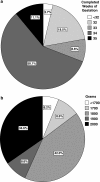Patient selection for neonatal extracorporeal membrane oxygenation: beyond severity of illness
- PMID: 19461595
- PMCID: PMC2834372
- DOI: 10.1038/jp.2009.57
Patient selection for neonatal extracorporeal membrane oxygenation: beyond severity of illness
Abstract
Objective: To explore how neonates with respiratory failure are selected for extracorporeal membrane oxygenation (ECMO) once severity of illness criteria are met, and to determine how conflicts between ECMO providers and parents over the initiation of ECMO are addressed.
Study design: A cross-sectional study was conducted using a data collection survey, which was sent to the directors of neonatal respiratory ECMO centers.
Result: The lowest birth weight and gestational age at which respondents would consider placing a neonate on ECMO were frequently below recommended thresholds. There was wide variability in respondents' willingness to place neonates on ECMO in the presence of conditions such as intraventricular hemorrhage and hypoxic ischemic encephalopathy. The number of respondents who would never seek to override parental refusal of ECMO was equal to the number who would always do so.
Conclusion: Significant variability exists in the selection criteria for neonatal ECMO and in how conflicts with parents over the provision of ECMO are resolved.
Figures



Similar articles
-
The changing demographics of neonatal extracorporeal membrane oxygenation patients reported to the Extracorporeal Life Support Organization (ELSO) Registry.Pediatrics. 2000 Dec;106(6):1334-8. doi: 10.1542/peds.106.6.1334. Pediatrics. 2000. PMID: 11099585
-
Neonatal Extracorporeal Membrane Oxygenation: Update on Management Strategies and Long-Term Outcomes.Adv Neonatal Care. 2016 Feb;16(1):26-36. doi: 10.1097/ANC.0000000000000244. Adv Neonatal Care. 2016. PMID: 26808515 Review.
-
Extracorporeal membrane oxygenation for the treatment of neonatal respiratory failure.Semin Cardiothorac Vasc Anesth. 2009 Sep;13(3):192-7. doi: 10.1177/1089253209347948. Epub 2009 Aug 26. Semin Cardiothorac Vasc Anesth. 2009. PMID: 19713207
-
UK collaborative randomised trial of neonatal extracorporeal membrane oxygenation. UK Collaborative ECMO Trail Group.Lancet. 1996 Jul 13;348(9020):75-82. Lancet. 1996. PMID: 8676720 Clinical Trial.
-
Current status of extracorporeal membrane oxygenation for severe respiratory failure.Artif Organs. 1996 Feb;20(2):120-3. doi: 10.1111/j.1525-1594.1996.tb00712.x. Artif Organs. 1996. PMID: 8712954 Review.
Cited by
-
Extracorporeal Membrane Oxygenation (ECMO) for suspected neonatal genetic diagnoses with cardiorespiratory failure.J Extra Corpor Technol. 2023 Sep;55(3):147-152. doi: 10.1051/ject/2023016. Epub 2023 Sep 8. J Extra Corpor Technol. 2023. PMID: 37682215 Free PMC article.
-
Impact of Kidney Disease on Survival in Neonatal Extracorporeal Life Support.Pediatr Crit Care Med. 2015 Jul;16(6):576-82. doi: 10.1097/PCC.0000000000000414. Pediatr Crit Care Med. 2015. PMID: 25828782 Free PMC article.
-
Genomic Contraindications for Heart Transplantation.Pediatrics. 2017 Apr;139(4):e20163471. doi: 10.1542/peds.2016-3471. Epub 2017 Mar 2. Pediatrics. 2017. PMID: 28255068 Free PMC article.
-
Anticipating uncertainty and irrevocable decisions: provider perspectives on implementing whole-genome sequencing in critically ill children with heart disease.Genet Med. 2018 Nov;20(11):1455-1461. doi: 10.1038/gim.2018.25. Epub 2018 Mar 1. Genet Med. 2018. PMID: 29493583 Free PMC article.
-
Neonatal respiratory extracorporeal membrane oxygenation and primary diagnosis: trends between two decades.J Perinatol. 2020 Feb;40(2):269-274. doi: 10.1038/s41372-019-0547-y. Epub 2019 Nov 7. J Perinatol. 2020. PMID: 31700091
References
-
- Bartlett RH, Gazzaniga AB, Jeffries MR, Huxtable RF, Haiduc NJ, Fong SW. Extracorporeal membrane oxygenation (ECMO) cardiopulmonary support in infancy. Trans Am Soc Artif Intern Organs. 1976;22:80–93. - PubMed
-
- ECMO Registry of the Extracorporeal Life Support Organization (ELSO) Ann Arbor, MI; January2009
-
- Van Meurs K, Lally KP, Peek G, Zwischenberger JB.ECMO Extracorporeal Cardiopulmonary Support in Critical Care3rd edn. Extracorporeal Life Support Organization: Ann Arbor, MI; 2005
-
- Survey Monkey . www.surveymonkey.com ; accessed 1/9/08.
-
- Bartlett RH, Roloff DW, Cornell RG, Andrews AF, Dillon PW, Zwischenberger JB. Extracorporeal circulation in neonatal respiratory failure: a prospective randomized study. Pediatrics. 1985;76:479–487. - PubMed
MeSH terms
LinkOut - more resources
Full Text Sources
Medical
Miscellaneous

